Men and women who played hockey together were dubbed “the mixers” by one newspaper and mixed hockey, which was not recognised by either the Hockey Association (HA) or All England Women’s Hockey Association (AEWHA), was popular throughout the country in the Edwardian era and in many areas this format of hockey had been the forerunner of both the men’s and ladies game since the 1880s.[i]
Hockey, formerly looked upon as a schoolboy’s amusement, has now become a fashionable pastime for ladies. Hockey clubs have been started in several neighbourhoods, somewhat on the lines of tennis clubs; both ladies and gentlemen become members, a suitable ground is procured, days and time for play arranged and tea provided on or near the ground. The game is played by ladies and gentlemen together, according to old rules, but in a somewhat quieter and more modified form, and it affords capital exercise and amusement on a cold winter’s day, as well as being a means of bringing young people together.[ii]
Mixed hockey was popular with the upper classes at country house weekends and mixed clubs playing with a soft ball had begun to form in some areas such as North Wales.[iii] Writing in 1909 Eustace White noted:
“At one time-—some half-dozen years ago—private mixed matches were very much the vogue in England, being affected by the aristocracy, and even by Royalty.
Much of this hockey was beautifully primitive and highly diverting. The ladies dressed for spectacular effect rather than for utility, while the men, in obedience to the fancied demands of decorum, eschewed the regulation hockey costume, and arrayed themselves in knee-breeches, high collars, and fancy waistcoats.”[iv]
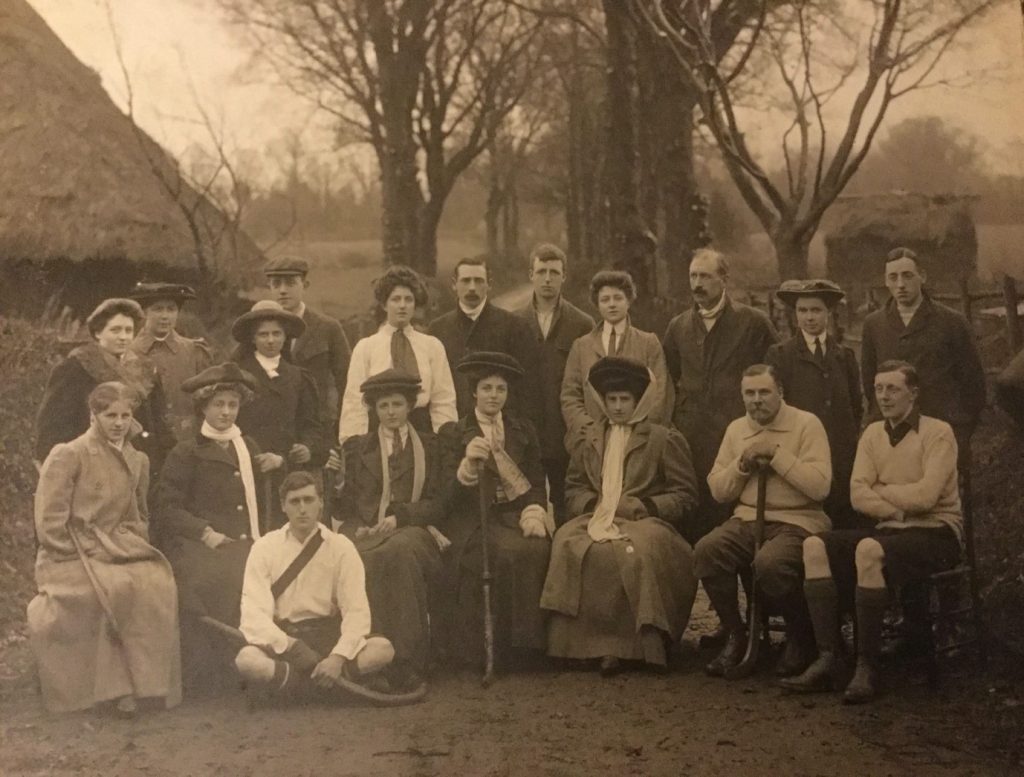
An Edwardian Country House Hockey Party
The Queen, the ladies newspaper, often made reference to country house parties and mixed hockey such as “At country house parties, when the weather permits, the most austere and athletic will not disdain to take part in mixed hockey-a travesty of the noble game, which can boast aristocratic patronage, but nevertheless is not recommended for everyday use.”[v] Nevertheless, it was popular with the royal family and in particular with Prince Arthur Duke of Connaught and his wife and daughters who were regular players.
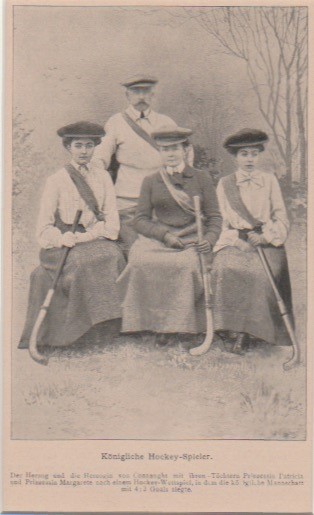
Prince Arthur
The Duke of Connaught & Strathearn
Princess Patricia
The Duchess of Connaught & Strathearn
Princess Margaret
Dublin 1904.
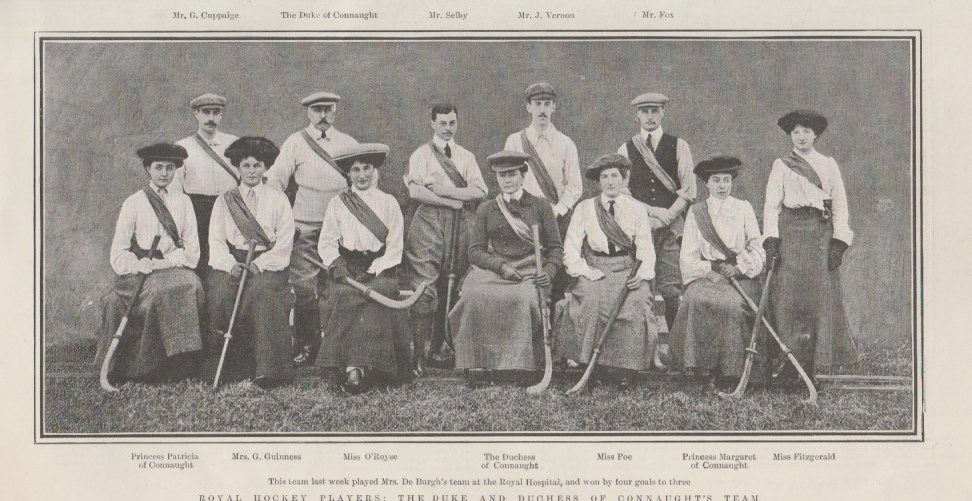
Illustrated London News: 30 January 1904
Despite its popularity in upper class circles the AWEHA officially discouraged the mixed game claiming “that women who played with men were much more concerned with their appearance than performance and with matrimonial rather than hockey goals” which had a ring of truth as it served as an opportunity for respectable men and women of the middle class to meet socially.[vi] Or as one newspaper put it “within the struggles of a mixed hockey, where cupid is regarded to wander in the mud.”[vii] Another suggested that after a hard mixed hockey match, with several large lumps on the shin from his lady’s stick, courtship while limping homeward would naturally be a little familiar, a little brusque.”[viii] There were few opportunities for many middle class ladies to meet men of a similar social standing un-chaperoned and mixed hockey was a new opportunity. Acknowledging the great revival of mixed hockey after the war, especially in the Midlands, the Boston Guardian journalist reminisced “in the good old days(pre-war) many mixed fixtures had their little social functions following the game and enjoyable hours were spent livened by song and dance.”[ix]
Hockey, like cycling and the Edwardian boom of roller skating was making a contribution to breaking the shackles of middle class chaperonage. Mixed hockey had post-match soirees in cricket club pavilions and town tea and coffee houses, annual balls, regular parties such as fancy dress (Scarborough HC), amateur dramatics (Withensea HC), sports days (Alderley Edge HC), and even mixed hockey tours (Clapham Ramblers HC 1912) to seaside hockey festivals. The hockey “bachelor girl” may have been the forerunner of the interwar “flapper” but it seemed likely she would become a hockey player’s wife. Hockey families were appearing in abundance. In Blackburn the first hockey club was a mixed club Brownhill HC (1904) who would soon become Blackburn HC. The lady captain Miss E Cooper and the men’s captain N. Sanderson resigned after three months and subsequently got married confirming the AEWHA view that mixed hockey often served as marriage maker amongst the middle classes.[x]
It is difficult to measure the extent of mixed hockey taking place as the two hockey newspapers The Hockey and The Hockey Field made little reference to it as they were the organs of the AEWHA and HA and when they did it was to condemn the sport for being dangerous for women to play and was of no benefit to a man. This view of the game was often replicated in the general press. “The man who regards mixed hockey as serious hockey will never be first class. He will rather deteriorate than improve.”[xi] Women who played were often demonized. “There is something about the game which make a woman forget her queenly dignity and come for a moment a sort of combination between a hurricane and a circular saw. Men, unless confirmed mixed hockey players, quail before her. Her stick mows a path down which she sprints for the goal… Whereas the old hand smiles quietly to himself and goes off and puts on two pairs of shin guards.”[xii] One international hockey player suggested that mixed hockey should be discouraged, as women who played mixed hockey were likely to be suffragettes.[xiii]
Mixed hockey’s popularity was strong in the industrial towns of the North and Midlands and in rural areas where numerous clubs were established. In the rural counties of Shropshire and Lincolnshire “where too many clubs appear addicted to mixed hockey. This variety of the game is strongly to be condemned for clubs that might aspire to play the game seriously.”[xiv] Despite press condemnation mixed hockey was growing in popularity such as in the hockey mad industrial town of Derby in 1905 where there were ten clubs playing men’s, ladies and mixed hockey on a Wednesday and Saturday. Two 1905 new clubs YMCA and North End had men’s, ladies and mixed teams with North End having 40 members in its first season.[xv]
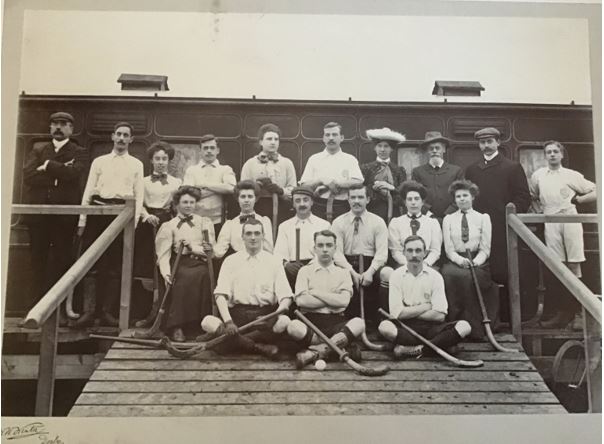
A Derby Mixed Hockey Team believed to be Derby White Swallow
Leagues and cup competitions, which were an anathema to both the HA and AEWHA who had both banned leagues and cup competitions, were soon part of the mixed hockey world. The first mixed hockey league East Durham Mixed Hockey League started in 1905 promoted by Murton Colliery’s manager Samuel Hare who served as the league president and provided the league trophy and medals. The league was won by West Hartlepool who defeated Hartlepool 2-0 in their final game despite goalkeeper Miss A. Watson having a good game making several fine saves in goal before a crowd of 50 spectators.[xvi]
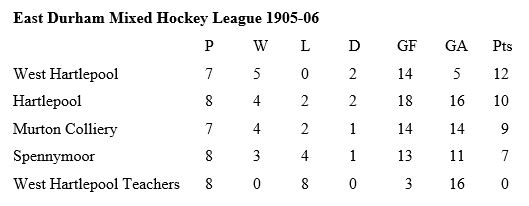
East Durham Mixed Hockey League 1905-6
Mixed hockey in the area was so popular that Spennymoor were even considering forming their own local district league.[xvii] At this time, virtually every village and town in Durham could boast a mixed hockey team from Jarrow in the north to Seaham on the coast to Bishop Auckland in the south. Durham and Northumberland’s keenness for mixed hockey would resume after the war with the formation of the Tyneside Mixed Hockey League and local cup competitions such as the Hexham Cup which was often won by the village team of Bellingham.
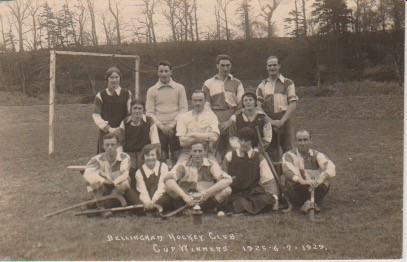
Bellingham HC Hexham Cup Winners 1925-6-7 and 1929
In 1929 a scheme was put forward in the North of England led by E. E. Eddon of Whitley Bay for the formation of an All England Mixed Hockey Association. Eddon had support from clubs on Tyneside and attempted to gain support from 160 clubs with the view that the MHA would be affiliated to both the HA and AEWHA and have the same status as a divisional association.[xviii] Neither association took it into consideration.
1919 had seen the formation of two mixed leagues, one by the Leicestershire Ladies and Mixed Hockey Association and the other in North Lincolnshire where various iron companies set up mixed company teams (Frodingham Iron & Steel Works, Appleby Iron Co. Ltd, North Lincoln Iron Co. Ltd, Winterton, Gunness & Burringham, Normanby Park) and formed a league. Company mixed hockey teams which seemingly started in Durham were to become commonplace in the interwar period.[xix]
The following year the West Riding Mixed Hockey League started with Bingley winning the first league title. The league had twelve teams mainly from Bradford and Leeds. Teams from Huddersfield and Wakefield would soon join the league.
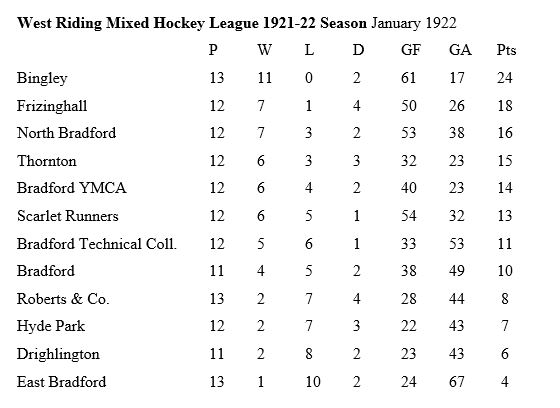
West Riding Mixed Hockey League 1921-22 Season
Within three seasons the Leicester and Leicestershire MHL would have three regional divisions with one in the city. In 1921 the city league had seven teams Hinckley Adelphi, Hinckley Baptists, De Montfort, Robert Hall, Rutland, Wasps and the YMCA.[xx] Melton Mowbray would win their regional league twice in the first three seasons. Mixed hockey in parts of the Midlands “became almost a craze” as Nottinghamshire Mixed HA and a Derbyshire Mixed HA were established before Xmas 1919.[xxi] The first mixed county game was played at Spinney Hill park between Leicestershire and Nottinghamshire in December followed by county games with Derbyshire.[xxii] Derbyshire had 12 mixed clubs with several fielding two teams and Derby Midland fielding three mixed teams.[xxiii]
In South Wales, the Cardiff mixed league started with ten teams in 1921 (Blenhiems, Board of Health, Dovic, Health, Optimists, Rhiwbria, Roath Park, St. Andrews, St. Athans, Taffs Well).[xxiv] Ten years later there were over 500 men and women playing mixed hockey in South Wales. Hockey was booming in the Rhondda valley:
The enthusiasm has become so great in the area that many clubs are agitating for the formation of a mixed hockey league in the Rhondda. Some clubs are able to field two, if not three teams on the same day. The clubs at Treherbert, Treorchy, Gelli, Clydach Vale and Taylorstown have all record memberships and at Penygraig, Porth, Ferndale and Mardy there is a determined move to form clubs.”[xxv]
Bristol in the mid 1930s had a mixed hockey league of eight teams but there seemed little appetite to form leagues elsewhere in the south of England. In 1935 the formation of the Weald of Kent & East Sussex Mixed HA with 13 clubs was an attempt to raise the standard of the game in the area and its Chairman gave an assurance that there would be no attempt to form a league though its annual six a side tournament did present a cup and medals.[xxvi]
Mixed hockey was the ‘cuckoo’ in the HA and AEWHA hockey world. The HA had originally refused to recognise the AEWHA. The AEWHA had banned men from taking up posts in their clubs yet here was a game that had men and women playing alongside each other competitively. Meanwhile, the game had royal approval and participation becoming fashionable in middle class society across the country and in some regions had become a “craze”. Despite calls for a mixed hockey to be part of their organisations they chose to ignore its popularity and commentary upon it in their newspapers was minimal and rarely positive to such an extent that one editorial in the Hockey Field read “mixed players appear to be unaware that they are universally taboo and considered neither fish, flesh nor good red herring.”[xxvii] The ‘mixers’ would be left out in the cold until 1977 when England Mixed Hockey Association was established and would eventually be recognised by the HA and AEWHA.
Article © of James Ormandy
References
[i] Acton Gazette 23rd December 1908
[ii] The Queen reprinted in the Dundee Evening Telegraph 9th January 1890
[iii] J. Nicholson Smith, P.A. Robson (1899) p150
[iv] E. E. White The Complete Hockey Player p165
[v] The Queen 31st December 1904
[vi] Kathleen E McCrone Playing the Game, Sport and the Physical Emancipation of Women 1870-1914 p133
[vii] Globe 5th February 1902
[viii] Lancashire Evening Post 2nd February 1907
[ix] Boston Guardian 6th November 1920
[x] Blackburn Hockey Club Fifty Years of Hockey in Blackburn 1904-1954 p6
[xi] Worthing Gazette 2nd November 2004
[xii] Globe 23rd January 1906
[xiii] North Wales Times 26th December 1908
[xiv] Athletic News 1st October 1906
[xv] Derby, Derby White Ribbon, Diocesan Training College, Technical College, Humbleton, North End, Sunny Hill, Trinity, Waverley, YMCA Sheffield Telegraph 30th September 1905
[xvi] Hartlepool Northern Daily Mail 4th April 1906
[xvii] Durham County Advertiser 14th September 1906
[xviii] Sheffield Daily Telegraph 9th October 1929
[xix] Sheffield Independent 1st October 1919
[xx] AEWHA Handbook 1922 p118
[xxi] Globe 12th November 1919
[xxii] Leicester Daily Post 11th December 1919
[xxiii] Sheffield Daily Telegraph 24th September 1919
[xxiv] Western 13th October 1921
[xxv] Western Mail 19th October 1932Kent & Sussex Courier 4th October 1935
[xxvi] Kent & Sussex Courier 4th October 1935
[xxvii] Hockey Field 4th October 1908

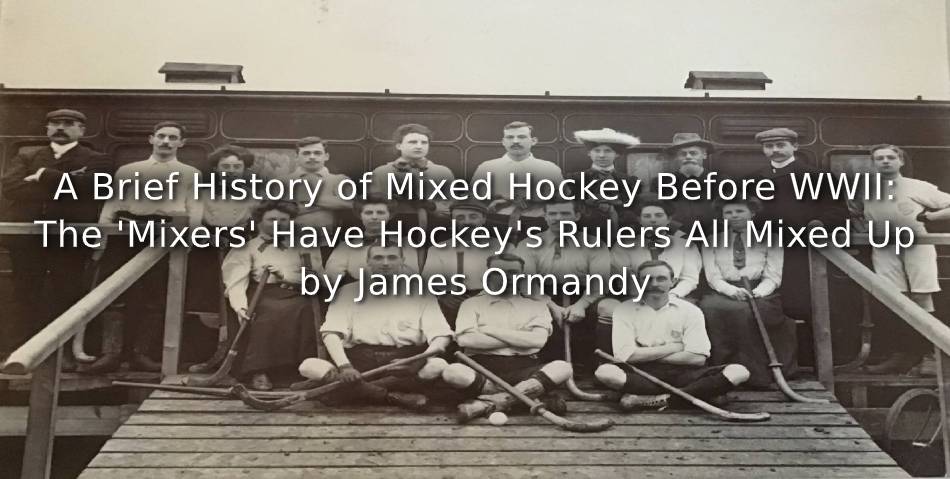
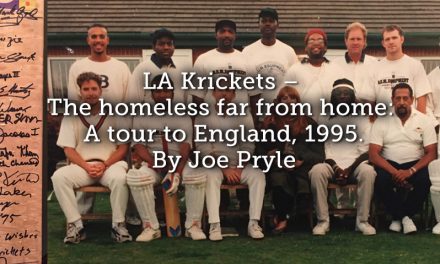

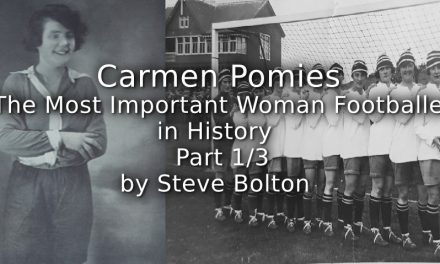
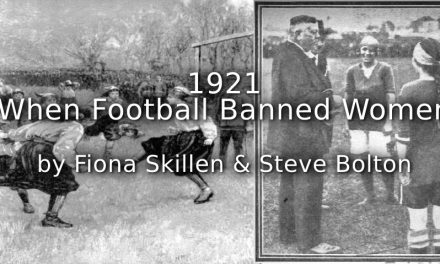
Mr. Ormandy,
You might be interested in the following extract from a letter to the Hereford times in 1903;
‘Personally, I consider mixed hockey a mongrel game, a farce which may at any moment turn into a tragedy. Picture the feelings of a man who has accidentally knocked a couple of front teeth down a fair opponent’s mouth, or has smashed her nose for her. Ought he to propose marriage? Perhaps some authoritative mixed-hockeyite will enlighten your readers on the etiquette of the game under such painful happenings.’
Unfortunately, no response can be traced.
Thanks for this Peter, I have recently spent some time researching hockey in Shropshire and Herefordshire. The Anglican Church clergymen virtually set up 9 out 10 clubs in Shropshire in the Edwardian era and Hereford HC was set up by the rowing club members who were looking for a winter sport that would keep them together socially. I have also come across recently an article on a young lady losing an eye but this was in a ladies game and there are several deaths on the hockey pitch reported in the 1920s. The first death on a hockey pitch is 1843 when Samuel Hilton ofChester received blow to the head from a stick whilst playing at Sandhurst Military College